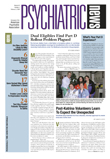Until recently, research on a pregnant woman's transmission of antidepressant medication to the fetus focused on the placenta and umbilical cord. Now a new study asks whether amniotic fluid may also be a source of antidepressants or their metabolites for the developing fetus.
“Fetal development occurs in a continuous environment of pharmacologically active drug molecules when mothers are treated with these medications,” wrote Ada Loughhead, B.S., of the Emory University School of Medicine in Atlanta and colleagues in the January American Journal of Psychiatry.
Prior research has identified possible effects on the fetus of maternal use of antidepressants, Marlene Freeman, M.D., told Psychiatric News. She is director of the Women's Mental Health Program and an assistant professor of psychiatry, obstetrics and gynecology, and nutritional sciences at the University of Arizona College of Medicine in Tucson.
Some mothers taking antidepressants late in pregnancy have had babies with a transient syndrome lasting two to four days, displaying jitteriness and trouble sleeping or eating, said Freeman. The Food and Drug Administration warned last December of increased rates (from 1 percent to 1.5-2 percent) of cardiac malformations in infants of mothers taking paroxetine in the first trimester of pregnancy.
The researchers reported on results from 27 women with confirmed exposure to antidepressants for at least four weeks prior to amniocentesis, which was performed for obstetrical reasons. Traces of antidepressants in both amniotic fluid and in maternal serum samples were recorded.
Loughhead and her team found antidepressant compounds in most of the amniotic fluid samples. All samples of amniotic fluid among women taking citalopram, escitalopram, fluvoxamine, and venlafaxine showed traces of the parent antidepressant. In addition, fluoxetine was detected in 11 of 12 fluid samples, paroxetine in one of two samples, and sertraline in two of six samples. Metabolites were found in amniotic fluid of nine of 12 fluoxetine users, four of six sertraline users, and all four venlafaxine users.
Maternal serum samples were available for 25 women. There was no consistent pattern in the proportion of parent and metabolite levels. The ratio of parent compound in amniotic fluid compared with serum ranged from 1.4 percent to 267.2 percent. The ratio for metabolites varied from 0.8 percent to 446.7 percent.
Amniotic fluid can be swallowed by the fetus and is inhaled at rates of 7 ml/day at 16 weeks gestation to 210-760 ml/day at term, said Loughhead and colleagues. “The significance of respiratory exposure to antidepressants in the fetus is unknown but can theoretically be both significant and efficient and would bypass fetal hepatic metabolism before [central nervous system] exposure.”
Deciding whether to treat pregnant women with antidepressants or other psychotropic medications is complicated, said Freeman.
“You must carefully weigh the risks of exposing babies to medications with the consequences of untreated maternal depression,” she said.“ We know there are also serious negative consequences of untreated maternal depression on infant outcomes.”
Both Freeman and Loughhead called for more research to study the effects on the fetus and routes of exposure of drugs taken by pregnant women. Such research and development might lead to new medications that less readily enter amniotic fluid, fetal circulation, or breast milk and thus raise fewer concerns for pregnant women and their physicians, wrote the study authors.
The study was funded by grants from Pfizer Pharmaceuticals, GlaxoSmithKline, and a National Institute of Mental Health Specialized Center of Research grant.
Am J Psychiatry 2006 163 145
